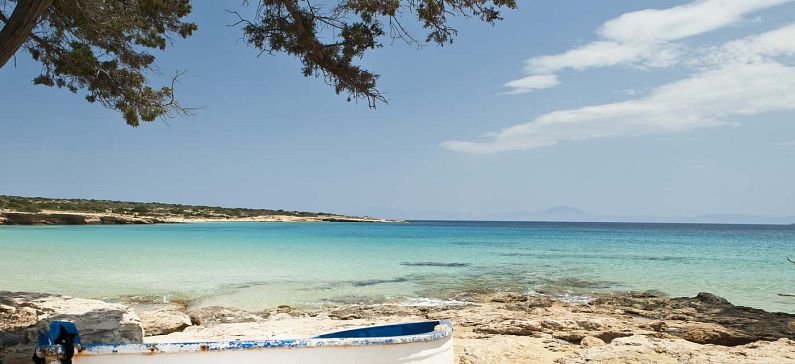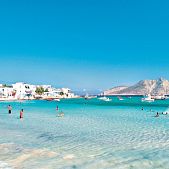
Koufonisia: Greece’s secret isles
Independent pays tribute to Koufonisia, Greece’s secret isles as described in the article’s title. Mykonos is one of the Med’s showiest party islands, the Greek counterpart to Ibiza: high-gloss, -cost and -energy, powered by thumping music and late night dinners, a hedonistic playground for hangovers and hookups that can easily become overwhelming. So, just as the White Island offers respite and solace on the nearby laid-back, boho island of Formentera, so Mykonos has a sister spot in the Cyclades with much the same bashful charm. The only difference is that Koufonisia is so little-known.
Read below segments of the article:
Part of its relative obscurity derives from the shade thrown by showy islands such as Mykonos and Naxos, easily accessed and well developed; mostly, though, the source of Koufonisia’s lower profile lies with basic logistics. Too far from Athens to lure daytrippers into the Aegean, there wasn’t even a direct ferry to the island until three years ago. Now, though, there’s a daily, seasonal, four-hour sailing on a high-speed ship from Piraeus. Yet even now, the island is not yet deluged with visitors, Greek or otherwise. In fact, the most comon language on its beaches and streets is Italian – by some estimates, they form around three quarters of visitors, mostly jetting in from Milan via nearby Naxos and a short ferry ride. The Italian fashion flock has already discovered the island – Roberto Cavalli and the Missonis are regulars, though they likely arrive under their own sail.
What’s known as Koufonisia (in English or Italian) is actually a trio of islands. The main island, Pano (Upper) Koufonisi, is home to the chora, or town, and the port at which that ferry from Athens arrives. Kato (Lower) Koufonisi is more windswept and unkempt, though still appealing, while the smallest spit of land in the archipelago, Keros, looms over the horizon from the main port. It’s off-limits to visitors; archaeologists have requisitioned the site to investigate the remains of ancient rituals here. These islands have been an allied trio since ancient times, though their liveliest era was late Middle Ages, during the trade wars between Venice and the Ottoman Empire; strategically located, Koufonisia became a sought-after staging post. It’s an insight into the local psyche that locals here didn’t ally with either empire but rather chose to support the freelancers, or what we’d call pirates.
There’s little sign of that turbulent history today, though. Strolling around the steep streets of the chora in Pano Koufonisi, rimmed with boxy, whitewashed buildings, shutters picked out in bright blue, it evokes a different kind of Greece. Squint slightly, and it’s easy to imagine Jackie just-turned-O sauntering down the cobbled alleyway that passes for a main street, an enigma swathed in oversized sunglasses and cash (indeed, bring plenty of Euros – few, if any, businesses accept credit cards). Yet this isn’t a jetset playground, but an unassuming hideaway, one where there are fewer than 400 full-time inhabitants; indeed, the much-repeated, though perhaps fanciful, maxim is that more fishing boats are moored around Koufonisia’s coast than there are locals living on land.
However many boats there might be, the local restaurants rely entirely on those fisherman for nightly supplies; if the notorious winds around the Cyclades have been too strong during the day, the glass cases in most restaurants will be half-empty. Don’t be disappointed, though: there’s plenty else on offer at old-fashioned tavernas.
As for souvenirs, the best shopping spot is Galleria Spigolo – of course, it’s owned by an expatriate Italian couple from Ancona; aside from stylish homewares, the duo handpaints brightly coloured, Pop-Arty T-shirts in situ. There’s little, if any, nightlife – for a nightcap, head to the souk-like Bar Scholio, which looks as if it’s been hollowed out from a cliff, the back bar festooned with an old seadog’s trophies and trinkets.
Like Mykonos and other windswept islands, there’s a windmill perched on the highest point above town;
Appealing as that pool might seem, the prime lure of Koufonisia is its astonishing beaches; reaching them is a pleasure in itself. Since there are few real roads, and little traffic, you can either hike across the island to its various sandy hideouts, or better still take one of the launches which leave regularly from a small hut on the main port. These maritime buses call in turn at the chain of beaches that line the island’s southern coast; the best strategy is to hop off at the terminus, Pori, and then slowly amble back on foot along the cliffs.
This final stop is an enormous, horseshoe-shaped beach; with its white sands and paddle pool-shallow bright blue water, it’s large enough to feel empty even in peak season. Better still, pause here for lunch – skip the shabby cafe near the dropoff point, and walk further to the stylish Kalofego, a beach bar that wouldn’t be out of place on the Italian Riviera; indeed, it even serves aperol spritzes in huge goblets, a nod to its clientele. Work off lunch with a dip in the natural swimming pool carved out of the rock by the crashing waters off the beach’s southern end – be brave, though, as you’ll have to jump in and swim out.
The coastline is dotted with rocky inlets, the perfect place for a private sunbathing session secluded from anyone strolling the clifftop. The next major beach is buzzier Fanos, where there’s a large bar staffed by iPad-ordering waiters and kitted out with bean-bags. Keep going and you’ll hit Ammos, the town’s main beach and the island’s least appealing, since it’s often packed with people toting suitcases and trying to soak up a few last moments of sun before hopping the ferry home from the port next door.
There are beaches on Kato Koufonisi, too, though this island is a stark contrast to the chic, sleek scene on Pano. Largely uninhabited, it’s a feasible daytrip; the boats leave from the same jetty at the port as the other beach shuttles, though less frequently. The first stop is at Venetsanos Taverna, the only restaurant on the island; it’s a comfy hideout, gingham tablecloths ranged inside a knickknack-crammed room that resembles the inside of Robinson Crusoe’s mind. Pick home-made dishes such as roasted aubergine from the glass cabinets and loll in the sunshine with copper pitchers full of local wine.
The second is at the main beach, Nero. It’s a stark contrast with Pori and co, in all senses. Pebbly and huge, without any facilities, its edges are rimmed with rockpools; bring waterproof shoes to clamber around and you’ll easily find a private nook for a picnic. There’s also room for tented camping at its western reaches; there’s usually a large community of naked hippies sunbaking and snoozing there – feel free to join them. At least here, there’s a flesh-baring scene even Ibiza and Mykonos might envy.













